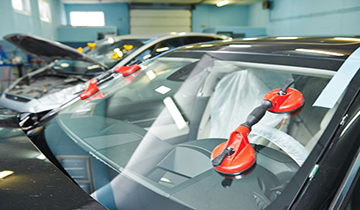
Most drivers understand that a cracked windshield can impair vision—but many don’t realize it can also interfere with something even more critical: airbag deployment. Your windshield isn’t just a barrier against wind and rain—it’s an integral part of your vehicle’s safety system.
At RAM Auto Glass, we educate customers about the hidden safety functions of auto glass. A properly installed, structurally sound windshield helps airbags deploy correctly and keeps you protected in the event of a crash.
Why Windshields Matter During a Crash
Your front windshield is designed as part of your car’s structural frame. In fact, according to NHTSA safety data, the windshield contributes up to 45% of a vehicle’s structural integrity in a frontal collision and up to 60% in a rollover.
When a crash occurs, your airbags need something solid to “bounce” against—that’s often the windshield. If the glass is damaged or poorly bonded, it may not hold in place long enough to support the airbag’s deployment path.
Passenger-Side Airbags Rely on Windshield Support
In many modern vehicles, the passenger-side airbag inflates upward toward the windshield, then bounces back to cushion the passenger. If the windshield detaches or shatters, the airbag may not function as intended. This can cause:
- Delayed deployment
- Reduced cushioning effect
- Improper trajectory of the airbag
- Increased risk of injury or ejection
That’s why it’s critical to repair or replace your windshield properly—even small chips can weaken the glass and compromise safety.
Proper Adhesive = Proper Deployment
Windshield adhesive is just as important as the glass itself. If the wrong urethane is used, or if it’s applied without proper priming and curing, the glass can detach during impact. In such cases, the airbag will deploy—but without a secure surface, it may “pop” through the space where the windshield should be.
At RAM Auto Glass, we only use crash-tested adhesives and follow OEM-approved bonding and curing times to ensure the windshield stays firmly in place during impact. This level of precision is essential for occupant protection.
ADAS Systems and Windshields
Many vehicles today are equipped with Advanced Driver Assistance Systems (ADAS) like lane departure warnings, adaptive cruise control, and emergency braking. These systems often rely on cameras mounted near or behind the windshield.
If the windshield is not properly aligned during replacement, the ADAS calibration can be thrown off—potentially delaying sensor response or triggering false warnings. We’ll always inform you if recalibration is needed after installation.
What Happens If the Windshield Is Cracked?
A cracked windshield may still look intact, but its structural capacity is reduced. During airbag deployment, this weakened structure may not absorb or redirect energy as designed. According to I-CAR training standards, even small cracks near the edge can compromise the integrity of the entire glass pane.
When Should You Replace It?
- If there are cracks near the edges or extending more than 6 inches
- If damage is in the driver or passenger’s direct line of sight
- If the glass was previously installed with low-quality adhesive
- If your vehicle’s ADAS sensors were misaligned due to impact or poor installation
Still unsure? Visit our FAQs page or call for a mobile assessment—we’ll let you know whether it’s safe to continue driving or if a replacement is recommended.
Related Reading
- Auto Glass Repair vs Replacement: How to Decide
- How to Spot Poor Auto Glass Installation
- What Makes a Good Auto Glass Technician?
Let’s Keep Your Windshield—and Airbags—Working as Designed
Your windshield plays a vital role in your vehicle’s crash safety and airbag performance. At RAM Auto Glass, we install and bond every windshield to meet or exceed factory specs. Whether it’s a chip, crack, or full replacement, our mobile service ensures your safety is never compromised.
Book your repair or call (647) 777-7080 for mobile auto glass service across Vaughan, Richmond Hill, and the GTA.
